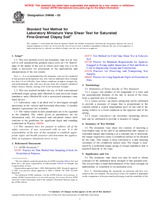We need your consent to use the individual data so that you can see information about your interests, among other things. Click "OK" to give your consent.
ASTM D4648-05
Standard Test Method for Laboratory Miniature Vane Shear Test for SaturatedFine-Grained Clayey Soil
STANDARD published on 1.6.2005
The information about the standard:
Designation standards: ASTM D4648-05
Note: WITHDRAWN
Publication date standards: 1.6.2005
SKU: NS-28026
The number of pages: 7
Approximate weight : 21 g (0.05 lbs)
Country: American technical standard
Category: Technical standards ASTM
Annotation of standard text ASTM D4648-05 :
Keywords:
clays, laboratory, miniature, remolded, saturated, shear value, undisturbed, undrained strength, ICS Number Code 93.020 (Earth works. Excavations. Foundation construction. Underground works)
Additional information
| Significance and Use | ||||||||||
|
The miniature vane shear test may be used to obtain estimates of the undrained shear strength of fine-grained soils. The test provides a rapid determination of the shear strength on undisturbed, or remolded or reconstituted soils. Note 2—Notwithstanding the statements on precision and bias contained in this test method: The precision of this test method is dependent on the competence of the personnel performing it and the suitability of the equipment and facilities used. Agencies that meet the criteria of Practice D 3740 are generally considered capable of competent and objective testing. Users of this test method are cautioned that compliance with Practice D 3740 does not in itself ensure reliable testing. Reliable testing depends on several factors; Practice D 3740 provides a means for evaluating some of those factors. |
||||||||||
| 1. Scope | ||||||||||
|
1.1 This test method covers the miniature vane test in very soft to stiff saturated fine-grained clayey soils (Φ = 0). Knowledge of the nature of the soil in which each vane test is to be made is necessary for assessment of the applicability and interpretation of the test results. Note 1—It is recommended that the miniature vane test be conducted in fine-grained, predominately clay soils with an undrained shear strength less than 1.0 tsf (100 kPa). Vane failure conditions in higher strength clay and predominantly silty soils may deviate from the assumed cylindrical failure surface, thereby causing error in the measured strength. 1.2 This test method includes the use of both conventional calibrated torque spring units (Method A) and electrical torque transducer units (Method B) with a motorized miniature vane shear device. 1.3 Laboratory vane is an ideal tool to investigate strength anisotropy in the vertical and horizontal directions, if suitable samples (specimens) are available. 1.4 The values stated in inch-pound units are to be regarded as the standard. The values given in parentheses are for information only. All measured and calculated values shall conform to the guidelines for significant digits and rounding established in Practice D 6026. 1.5 This standard does not purport to address all of the safety concerns, if any, associated with its use. It is the responsibility of the user of this standard to establish appropriate safety and health practices and determine the applicability of regulatory limitations prior to use. |
||||||||||
| 2. Referenced Documents | ||||||||||
|
We recommend:
Technical standards updating
Do you want to make sure you use only the valid technical standards?
We can offer you a solution which will provide you a monthly overview concerning the updating of standards which you use.
Would you like to know more? Look at this page.




 Cookies
Cookies
